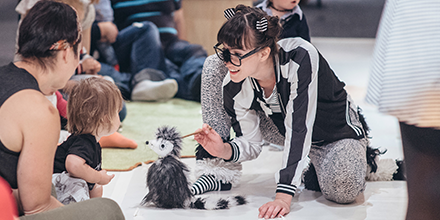Audio description provides additional narration, normally live rather than an audio track, describing what is happening on the screen or stage during natural pauses in the audio or during dialogue. This is provided for visually impaired people.
In performing arts such as theatre, opera or dance, audio description describes body language, expressions, movements and lighting effects. The describers will time the description so that it does not overlap the actors’ lines.
To participate in an audio description, the listener wears a personal set of ear-phones (provided by the theatre), which allow each individual to regulate the volume and listen to a live description relayed by the audio describer - Audio Description Association 2019
This is useful for blind and visually impaired audience members, as well as those with learning differences and / or learning disabilities.
Developing your show
Audio description can be provided in different ways:
Typical method
- The audio is transmitted to a headset via infrared, radio or Wi-Fi. This normally requires a trained audio describer.
- Audio description units come in different sizes, large stationary and small portable units.
- Small units are suitable for venues with less space, site-specific productions and walking tours and events.
- If you are thinking about using audio description at the Fringe, check with your venue to see if they have borrowed the Fringe audio description set. The borrowing of this equipment will also include a contribution from the Fringe Society towards paying for an audio describer.
Integrated method
- Audio description can be embedded within the performance for the entire audience. This won’t require headsets and can be provided by a character on stage, or by transmitting it through a venue PA system.
- Methods that could achieve this include providing a commentary over the action or self-narration, where actors tell the audience about the characters, describe the situation or provide information between scenes.
- Suggested genres this can work for include, but are not limited to, theatre, children’s shows, musicals and physical theatre.
What does an audio describer need?
- Access to an up-to-date script as a Word document.
- A good quality recording (not audio only) on video or DVD, or access to record the performance.
- Opportunities to see the show beforehand, two or three times, at the Fringe venue or at a pre-festival production. Due to the nature of the Fringe, when running times can be shorter, audio describers may be able to view the show fewer times. These viewings allow the audio describer to work out timings.
- Factor in prep time. If there are no opportunities to view the show before the Fringe, then you may want to look at later dates in your run for the audio described performance/s.
Cost
Consider booking the audio describer more than once. Most of the expenditure is based on the preparation stage, so extra performances should cost very little. This also allows word of mouth to spread during the Fringe, resulting in a higher probability of attendance from your target audience.
Working with venues
- We have access to some funding to help venues make their shows more accessible, so if you'd like to include audio description in your show, ask your venue to get in touch with us via [email protected] and we'll see how we can help.
- Especially for the typical method, space will need to be allocated away from the audience (the audio describer will be talking during the performance). This can be space in a tech box or separate room if the performance can be relayed via webcam.
- Space in venues at the Fringe can be a challenge. If you are interested in providing audio description, consider this at the start of the process of looking for venues, to make sure the venue can provide space. A good starting point would be to look at venues who have experience of audio described performances.
- Large units require access to a mains supply. Small units can be charged in their case over a 24-hour period.
- Audio describers normally set up the equipment themselves but need time before the performance to sound check with the venue technician, so communicate with the venue!
- Audio describers need time to set up and take down the equipment before and after the performance, so communicate with the venue!
- Ask the venue if front of house and box office staff can be made aware of the performance, as there may be audience members with access requirements.
- Will venue staff be available to assist with any audience access requirements? Speak to your venue, they may be able to assign extra staff for this purpose on the day. It is also beneficial if staff have taken disability awareness training (such as the Fringe Society’s free online training).
- Ask the venue if early access can be provided to audience members with access requirements, as this can be very beneficial in the busy Fringe environment.
